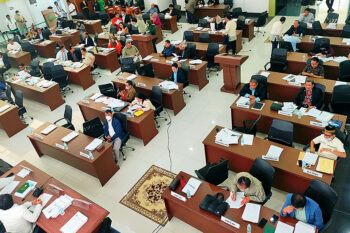CAGAYAN DE ORO CITY (MindaNews / 19 July) — On July 13, the order mandating the temporary shutdown of 55 Lumad schools operating under the nonprofit Salugpongan Ta’ Tanu Igkanogon Community Learning Centre Inc. in the Davao region became public.
The order was hinged on the findings of National Security Adviser Secretary Hermogenes Esperon Jr., who heads the Task Force to End Local Communist Armed Conflict. According to the task force’s report, the closure was based on the finding that the Lumad schools deviated from the curriculum set by the Department of Education, and that the students were taught by the school officials to rebel against the government, among others.
The task force also considered a statement from Melvin Loyod, a former teacher at one of the schools, to be persuasive in the decision to order a closure. In the statement, he claimed that teaching materials included the anthem of the New People’s Army and firearm instruction. Many individuals and groups have since expressed their dissent with this decision, with Bayan Muna Rep. Carlos Isagani Zarate stating that Education Secretary Leonor Briones can be filed with graft charges for arbitrarily shutting down the schools without due process.
In this article, written with my lawyer colleague Joy Reyes, I argue that such closure of Lumad schools is in violation of domestic and international laws, and that instead of closing these institutions, the government should instead provide support for their continued existence.
Lumad schools
This most recent closure is not the only instance where Lumad schools were accused of indoctrinating children. In 2017, President Duterte claimed that these Lumad schools are operating illegally and threatened to shut them down. Since then, plenty of other claims have been made against the creation and operation of these schools, which has prompted many rights groups and representatives of the communities to clamor for the saving of Lumad schools.
Situated in areas that government schools may not be able to reach because of their geographical isolation, these Lumad schools are the main sources of instruction for many of the children in the area, where literacy, numeracy, and skills are taught by mostly volunteers. The curricula of these indigenous peoples are also slightly different from those in other places because of the circumstances affecting their location and the socioeconomic realities of the communities. For this reason, in 2015, the Department of Education adopted the indigenous people (IP) education curriculum framework in order to provide guidance to schools. This was a response to the need to design a curriculum that is culturally-responsive and appropriate. Its materials are contextualized to the community and is composed of concepts that are relevant to the community, including respect for their cultural identity and ancestral domain. Such a method of instruction envisions to empower the communities and, according to then DepEd Secretary Luistro, “enable learners to be future culture-bearers, capable of exercising their right to self-determination as they interact with other cultures.”
It is for this reason that I am in support of the Lumad schools. One must also know the context of this recent decision by the DepEd and see the big picture of what this is about.
Context of the closure
This is not the first time the national government, upon the egging of the military, has clamped down on Lumad schools. During the Aquino administration, there was even a wave of killings of Lumad leaders in 2015. That led me to write an article in Rappler “Leave the Lumad alone!” where I explained what was happening:
“Why should we care about the Lumad? We must be concerned because they are among the poorest and marginalized in our society.
“The Lumad are also among the most peaceful and gentle, and therefore the most vulnerable. When provoked however, like their counterparts in Luzon and the Visayas, the Lumad fight back as they have done with the Spanish and American colonizers and the national government in the more recent past. Because many of the island’s natural resources, especially minerals, are in Lumad territory, they are frequently attacked and their ancestral domains encroached upon by outsiders. Such development aggression in turn becomes the breeding ground of the national democratic revolution and the communist insurgency.
“There will be no peace in Mindanao and in the Philippines if the rights of the Lumad are ignored and disregarded. Even the successful establishment of the Bangsamoro will not lead to peace without the full inclusion of the Lumad.”
My perspective on this is based on my experience of having worked in many Lumad areas for 30 years now as an environmental and human rights lawyer. I know the dynamics very well in Lumad areas and am aware that are two elephants in the room here – at a superficial level, the communist insurgency and the national democratic revolution which finds the Lumad squeezed between the military and the New People’s Army; But at a deeper level, this is about control over natural resources, especially the minerals, that are abundant in Lumad territory.
I also wrote in 2015 about the complicity of DepEd in what was being done to the Lumad, repeated again today. Knowing the good people that led the department then and are leading the department now, I have to assume that they did and do not intend to marginalize the Lumad more. But these are the unintended consequences when redbaiting propaganda is accepted without question. People die as a result when that happens. School are closed at the detriment of childre
Domestic and International Law
No less than the 1987 Constitution of the Philippines mandates the State to protect and promote the right of all citizens to quality education at all levels and shall take appropriate steps to make education accessible to all. Section 2(4) of Article XIV provides that the State shall “encourage non-formal, informal, and indigenous learning systems, as well as self-learning, independent, and out-of-school study program particularly those that respond to community needs.” Section 17 of the same Article states that “The State shall recognize, respect, and protect the rights of indigenous cultural communities to preserve and develop their cultures, traditions, and institutions.” Finally, Section 22 of Article II dictates the State’s recognition and promotion of the rights of indigenous cultural communities within the framework of national unity and development.
Being the supreme law of the land, the Philippine Constitution calls for the protection, preservation, and celebration of indigenous communities, including the Lumad, and their right to an education that is relevant to their needs and the needs of their communities. In order to alleviate concerns after the closure, the Department of Education has pronounced that the 11,000 Lumad students may enrol in public schools. However, such is a violation of the fact that Lumad students, being part of the indigenous communities, have different learning priorities, and should be taught using the medium that is most relevant to them. Such is the concept of self-determination.
In addition to the Constitutional provisions, Republic Act No. 8371, or the Indigenous Peoples’ Rights Act of 1997, provides that the State shall provide a complete, adequate, and integrated system of education, without prejudice to their right to establish and control their educational systems and institutions by providing education in their own language, in a manner appropriate to their cultural methods of teaching and learning.
On a global scale, the United Nations Declaration on the Rights of Indigenous Peoples (UNDRIP) defines the rights of indigenous peoples, including, but not limited to, their ownership rights to cultural expression and education. It reaffirms that the indigenous peoples, in the exercise of their rights, should be free from discrimination of any kind, and it recognizes the urgent need to respect and promote these inherent rights which stem from their political, economic, and social structures. Article 13 of the UNDRIP provides that indigenous peoples have the right to revitalize, use, develop and transmit to future generations their histories, languages, oral traditions, philosophies, writing systems, and literatures. In the next article of the UNDRIP, it says that they have the “right to establish and control their educational systems and institutions providing education in their own languages, in a manner appropriate to their cultural methods of teaching and learning,” and that “indigenous individuals, particularly children, have the right to all levels and forms of education of the State without discrimination.” This document encompasses the responsibility of all member-states to uphold the dignity of their indigenous peoples, and to work alongside them in order to solve global issues.
All told, it is evident that over the last couple of decades, it has been witnessed and internationally acknowledged that indigenous peoples comprise a significant number of the population. Gone are the days when indigenous peoples are ignored when it comes to policy-making. Today, with their increasing populations and their continued contributions to the development of the nation, they are rightfully put to the forefront. Our indigenous peoples are the first to be affected by natural calamities given their geographical locations, and oftentimes are the last to receive governmental aid should these calamities strike. They are the first to feel the effects of rapid industrialization, and usually the first to be displaced from their communities when it happens. It is precisely because of these that they should be even more empowered.
Reopen the Lumad schools!
The indigenous peoples, and the Lumad students specifically, should be given the opportunity to learn more about their culture and how to preserve it, learn more about their environment and how to defend it. They should be taught in a manner that upholds their dignity both as a Filipino citizen and a member of their community. Instead of having their schools taken away from them, where they are taught tools that are valuable to their daily living –tools that may not be taught in the mainstream educational system– the government should instead support these schools and ensure their continuous operations, not close them down and leave the Lumad students in a state of loss. The Lumad schools underlie the realities of the Lumad struggle and equip the students with skills necessary for them to navigate daily life, including not just literacy and numeracy but also agriculture, weaving, and working. They empower the Lumad youth and impress upon them their individual human rights, especially in the areas where the schools are located which are usually heavily militarized. They are run and taught by teachers, many of whom are volunteers, who, despite the lack of facilities and manpower, still continue to educate the youth.
Truly, to allow and support the continued operations of the Lumad schools is for the betterment of our Lumad students, and for the betterment indeed, of our nation.
For the sake of justice and the future of Mindanao, and for the children of the Lumad, reopen their schools! MindaViews is the opinion section of MindaNews. Tony La Viña of Cagayan de Oro City is former Dean of the Ateneo School of Government. He teaches Constitutional law in Law schools in Manila and Mindanao)







